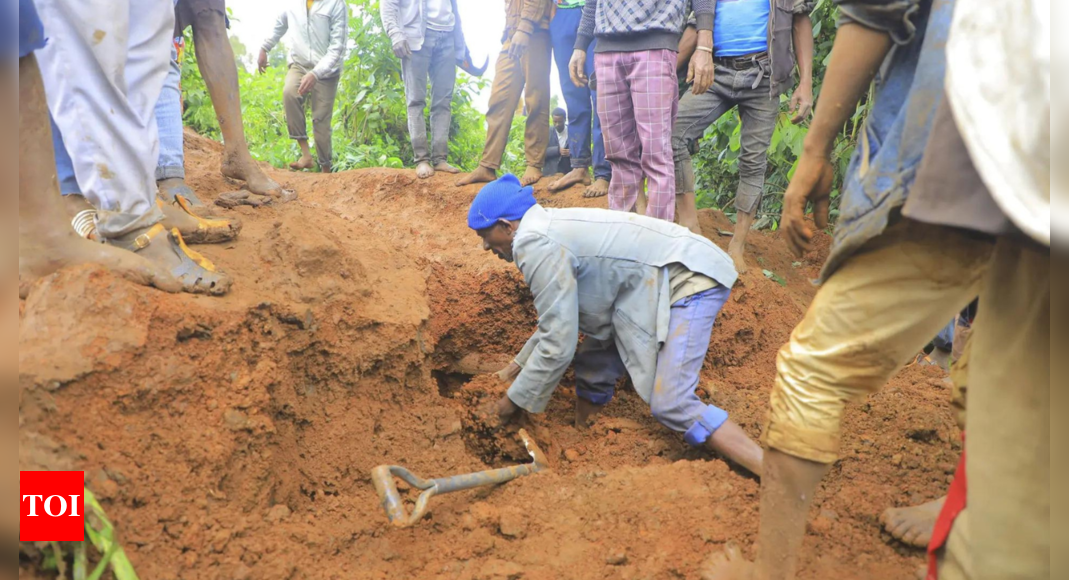
Local residents in a remote area of southern Ethiopia searched for survivors using shovels and their bare hands on Tuesday after a devastating landslide claimed the lives of at least 229 people, making it the deadliest such disaster recorded in the country.
According to a statement from the local communications affairs department, 148 men and 81 women have been confirmed dead after the disaster occurred in the Kencho-Shacha locality in the Gofa Zone on Monday.The Ethiopian Broadcasting Corporation reported earlier that five people had been rescued alive from the mud and were receiving medical treatment.
Firaol Bekele, early warning director at the Ethiopian Disaster Risk Management Commission (EDRMC), told AFP that initially, four households were affected by the landslide, and later, households in the area were mobilized to save lives. “But they too perished when the landslide engulfed them,” he said, attributing the disaster to heavy rains that had battered the area on Sunday night.
Ethiopia, with a population of around 120 million people, is highly vulnerable to climate disasters such as flooding and drought.
Prime Minister Abiy Ahmed expressed his deep sadness over the terrible loss on X, saying that the Federal Disaster Prevention Task Force had been deployed to the area to reduce the impact of the disaster.
African Union Commission chief Moussa Faki Mahamat offered his condolences and solidarity with the families of the victims and the Ethiopian government on X, as rescue efforts continue to find the missing and assist the displaced.
Gofa, located in the South Ethiopia regional state, is approximately 450 kilometers (270 miles) from the capital Addis Ababa, although the distance takes around 10 hours to drive. An Ethiopian refugee living in Kenya who is from a district near the disaster site described the area as rural, remote, and very mountainous, with weak soil that runs down to the ground below during heavy rains and landslides. He noted that similar disasters have occurred in the past, with more than 20 people killed last year and people dying almost every rainy season due to landslides and heavy rains in the area.
The South Ethiopia state had already been affected by seasonal rains between April and early May, causing flooding and mass displacement, according to the UN’s humanitarian response agency OCHA. In May, floods affected more than 19,000 people in several zones, displacing over 1,000 and causing damage to livelihoods and infrastructure.
Previous landslides in Ethiopia include a 2016 incident in Wolaita, South Ethiopia, where 41 people were killed following heavy rains, and a 2017 disaster in the outskirts of Addis Ababa, where 113 people died when a mountain of garbage collapsed in a dump. The deadliest landslide in Africa occurred in Sierra Leone’s capital, Freetown, in August 2017, claiming 1,141 lives. In February 2010, mudslides in the Mount Elgon region of eastern Uganda killed more than 350 people.
According to a statement from the local communications affairs department, 148 men and 81 women have been confirmed dead after the disaster occurred in the Kencho-Shacha locality in the Gofa Zone on Monday.The Ethiopian Broadcasting Corporation reported earlier that five people had been rescued alive from the mud and were receiving medical treatment.
Firaol Bekele, early warning director at the Ethiopian Disaster Risk Management Commission (EDRMC), told AFP that initially, four households were affected by the landslide, and later, households in the area were mobilized to save lives. “But they too perished when the landslide engulfed them,” he said, attributing the disaster to heavy rains that had battered the area on Sunday night.
Ethiopia, with a population of around 120 million people, is highly vulnerable to climate disasters such as flooding and drought.
Prime Minister Abiy Ahmed expressed his deep sadness over the terrible loss on X, saying that the Federal Disaster Prevention Task Force had been deployed to the area to reduce the impact of the disaster.
African Union Commission chief Moussa Faki Mahamat offered his condolences and solidarity with the families of the victims and the Ethiopian government on X, as rescue efforts continue to find the missing and assist the displaced.
Gofa, located in the South Ethiopia regional state, is approximately 450 kilometers (270 miles) from the capital Addis Ababa, although the distance takes around 10 hours to drive. An Ethiopian refugee living in Kenya who is from a district near the disaster site described the area as rural, remote, and very mountainous, with weak soil that runs down to the ground below during heavy rains and landslides. He noted that similar disasters have occurred in the past, with more than 20 people killed last year and people dying almost every rainy season due to landslides and heavy rains in the area.
The South Ethiopia state had already been affected by seasonal rains between April and early May, causing flooding and mass displacement, according to the UN’s humanitarian response agency OCHA. In May, floods affected more than 19,000 people in several zones, displacing over 1,000 and causing damage to livelihoods and infrastructure.
Previous landslides in Ethiopia include a 2016 incident in Wolaita, South Ethiopia, where 41 people were killed following heavy rains, and a 2017 disaster in the outskirts of Addis Ababa, where 113 people died when a mountain of garbage collapsed in a dump. The deadliest landslide in Africa occurred in Sierra Leone’s capital, Freetown, in August 2017, claiming 1,141 lives. In February 2010, mudslides in the Mount Elgon region of eastern Uganda killed more than 350 people.









